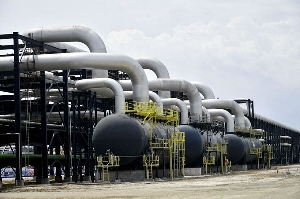Regional News of Friday, 1 June 2012
Source: GNA
Newmont “investigates” death of fish in Ahafo Mine
Newmont Ghana, says it is investigating the discovery of dead fish in one of its Ahafo Mine Environmental Control Dams (ECDs) in the Brong Ahafo Region following days of rainfall.
It says the Environmental Protection Agency, Mines Inspectorate Division of Minerals Commission as well as Water Resources Commission have been informed about the incident and an investigation is underway into the possible causes.
Mr. Eric Addae, Asutifi District Chief Executive as well as the chiefs have also been informed about the situation.
Newmont said in a statement on Friday that a preliminary assessment had established that there was no discharge of any substance from the mine or processing operations that could have led to the death of the fish.
“We are continuing to monitor the situation closely, as more rains are expected, and will keep our stakeholders, including regulators and communities apprised of developments as well as results from the investigation,” the statement said.
The Environmental Control Dams are used to collect storm water from the operational areas and are not designed or used to receive discharges from the processing facilities.
Sediments in the storm waters collected in the ECDs are allowed to settle to EPA compliant levels before the water is tested and released downstream in a controlled manner.
Mr. Maxwell Atuahene, Assemblyman for Ntotroso, told Ghana News Agency that he was informed of the incident on Wednesday.
He added that his investigations revealed that, there were some dead tilapia and mud fish floating on the surface of the Environmental Control Dam Two (ECD 2) area at Manukrom, near Ntotroso in Asutifi District of Brong-Ahafo.
The river flows into River Tano downstream for the inhabitants of Achirensua and Hwidiem.
The assemblyman stated that he informed Barima Twereku Ampem III, Divisional Chief of Ntotroso, about the incident.
Barima Ampem confirmed he had been informed but was yet to hear from Newmont and the Environmental Protection Agency (EPA). The chief added that he would also visit the site to verify.
Mr. Peter Ntiamoah Hodgson, Principal Inspector of Mines, Inspectorate Division of Minerals Commission-Kumasi Office, responsible for the Northern Sector, said the Commission had been following the death of fish at the Water Storage Facilities (WSFs) of Newmont for about a year now and realised the deaths were caused by physical reasons and not chemical contamination.
He said “Even if the cause is chemical, it was not cyanide but Amonia through eutrophication”, adding the physical cause occurs through change in temperature due to heavy downpour”.
Mr. Hodgson implied that heavy rainfall in the area for the past days had led to the increase of the volume and flow of the River Awonsu, hence the increased volume of the ECD2 which was nearly overflowing its banks.
He said this might have physically caused the death of the fish.
The Principal Inspector of Mines, disclosed another physical cause “is Turbidity and Total Suspended Solids (TSS)” saying that could also be the reason why the dead fish were found floating on the surface of the ECD 2.
He gave the assurance that samples of the water and dead fish had been taken to the SGS and Food and Drugs Board (FDB) laboratories in Accra for investigation and analysis.
Mr. Kwame Agbeko Azumah, Communications Manager of NGGL Ahafo Mine, earlier confirmed to newsmen at the ECD 2 site that dead fish was detected floating on the surface of the dam on Wednesday morning.
He explained that the ECD 2 and all others were restricted areas, so a security guard on duty informed the company’s environmental office and officers came to verify and collect samples of the water and the fish to their laboratory.
Mr. Azumah stressed the incident was under investigation but initial investigation showed no spillage of cyanide.
He emphasised that when they went to the tributary of River Awonsu upstream, they detected no dead fish.**
Entertainment









